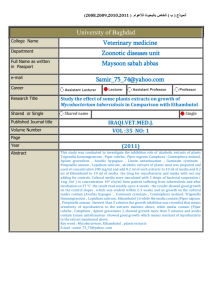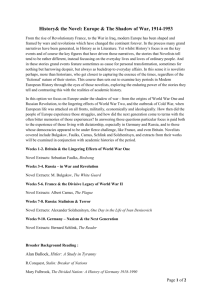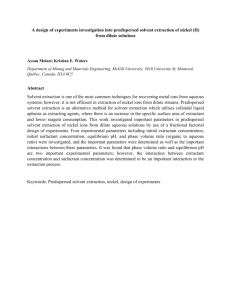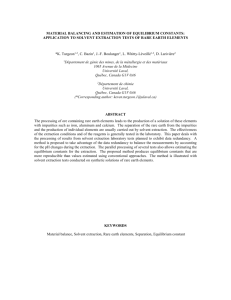Extraction methods
advertisement
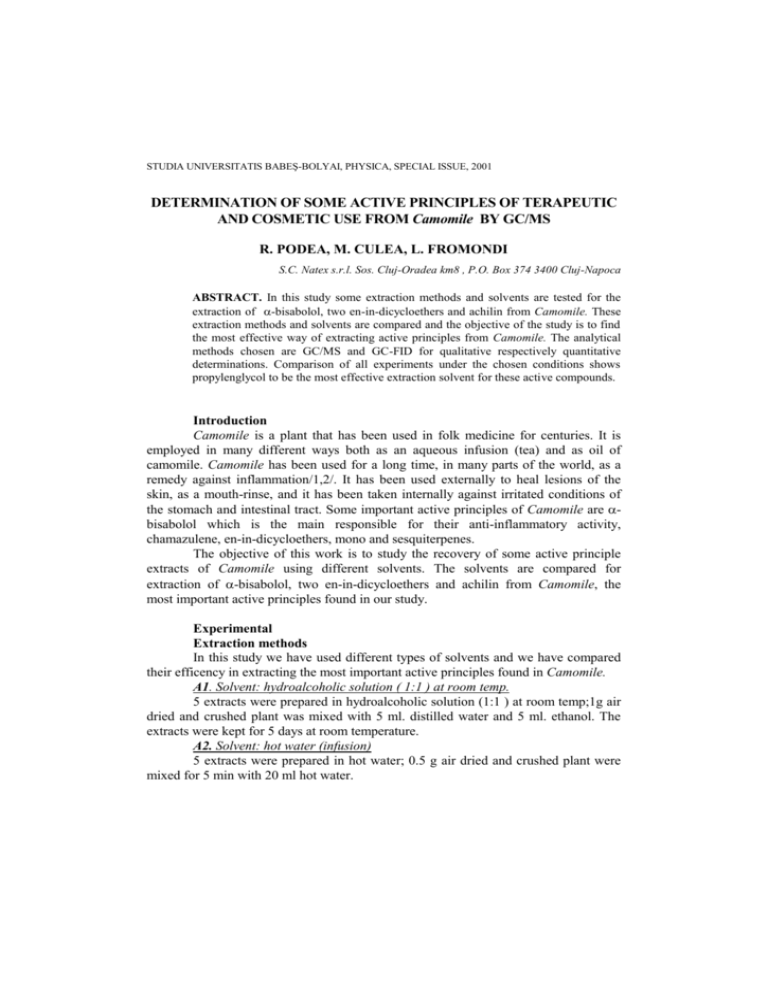
STUDIA UNIVERSITATIS BABEŞ-BOLYAI, PHYSICA, SPECIAL ISSUE, 2001 DETERMINATION OF SOME ACTIVE PRINCIPLES OF TERAPEUTIC AND COSMETIC USE FROM Camomile BY GC/MS R. PODEA, M. CULEA, L. FROMONDI S.C. Natex s.r.l. Sos. Cluj-Oradea km8 , P.O. Box 374 3400 Cluj-Napoca ABSTRACT. In this study some extraction methods and solvents are tested for the extraction of -bisabolol, two en-in-dicycloethers and achilin from Camomile. These extraction methods and solvents are compared and the objective of the study is to find the most effective way of extracting active principles from Camomile. The analytical methods chosen are GC/MS and GC-FID for qualitative respectively quantitative determinations. Comparison of all experiments under the chosen conditions shows propylenglycol to be the most effective extraction solvent for these active compounds. Introduction Camomile is a plant that has been used in folk medicine for centuries. It is employed in many different ways both as an aqueous infusion (tea) and as oil of camomile. Camomile has been used for a long time, in many parts of the world, as a remedy against inflammation/1,2/. It has been used externally to heal lesions of the skin, as a mouth-rinse, and it has been taken internally against irritated conditions of the stomach and intestinal tract. Some important active principles of Camomile are bisabolol which is the main responsible for their anti-inflammatory activity, chamazulene, en-in-dicycloethers, mono and sesquiterpenes. The objective of this work is to study the recovery of some active principle extracts of Camomile using different solvents. The solvents are compared for extraction of -bisabolol, two en-in-dicycloethers and achilin from Camomile, the most important active principles found in our study. Experimental Extraction methods In this study we have used different types of solvents and we have compared their efficency in extracting the most important active principles found in Camomile. A1. Solvent: hydroalcoholic solution ( 1:1 ) at room temp. 5 extracts were prepared in hydroalcoholic solution (1:1 ) at room temp;1g air dried and crushed plant was mixed with 5 ml. distilled water and 5 ml. ethanol. The extracts were kept for 5 days at room temperature. A2. Solvent: hot water (infusion) 5 extracts were prepared in hot water; 0.5 g air dried and crushed plant were mixed for 5 min with 20 ml hot water. DETERMINATION OF SOME ACTIVE PRINCIPLES OF TERAPEUTIC AND COSMETIC USE … A3 .Solvent: PG + water at room temp. 3 kinds of extracts were prepared by mixing 0.5 g dried plant with three propylenglycol solutions of 10%, 25% and 50%. The extracts were kept for 5 days at room temperature. A4. Solvent: PG + hot water. 2 kinds of extracts were prepared by mixing 0.5 g dried plant with two propylenglycol solutions of 25% and 50%. The extracts were mixed for 5 min. A5. Solvent: ethanol 100% at room temp. 5 extracts were prepared by mixing 1g air dried and crushed plant with 10 ml. ethanol. The extracts were kept for 5 days at room temperature. A6. Solvent: PG 100% at room temp. 5 extracts were prepared by mixing 0.5 g dried plant with 10 ml 100% PG. The extracts were kept for 5 days at room temperature. B).In the second part of the study we have used propylenglycol (PG, 100 %) as extraction solvent and we have prepared four kinds of extracts in different concentrations: 5 % (0.5 g plant + 10 ml PG), 10 % (1 g plant + 10 ml PG), 15 % (2 g plant + 13.4 ml PG), 20 % (2 g plant + 10 ml PG). The extracts were kept for 7 days at room temperature. Under vacuum filtration of the extracts we have obtained the following amounts of liquid extract: -solution 5 % : 10 ml PG gave 8.6 ml extract -solution 10 % : 10 ml PG gave 7.8 ml extract -solution 15 % : 13,4 ml PG gave 8 ml extract -solution 20 % : 10 ml PG gave 5.8 ml extract Sample preparation for GC-FID and GC/MS 1.5 ml of each of the following extracts B, A3, A4 and A6 was mixed with 4.5 ml distilled water , 1ml solvent A (ethyl acetate:hexane:methylen chloride 5/1/1, v/v/v), 2 g NaCl and 1333 µg/g internal, standard methyl undecenoate, (C11:1) for 5 min and 4µl were injected in GC-FID. 3 ml of each of the following extracts A1, A5 was mixed with 3 ml distilled water, 1ml solvent A, 2 g NaCl and 1333 µg/g IS for 5 min, and 4µl were injected in GC-FID. 6 ml of extract A2 was mixed with 1ml solvent A, 2g NaCl and 1333 µg/g IS for 5 min and 4µl were injected in GC-FID. GC-FID Analysis GC-FID analysis was performed with a Hewlett Packard GC system 6890 with FID. Compounds were separated on a 30m x 0.25mm HP-5 fused-silica capillary column coated with 0.25µm film. The column was maintained at 50C for 2 min after injection, then programmed at 8C/min to 250C, then 30C/min to 310C which was maintained for 10 min. Helium was used as carrier gas with a flow rate of 1ml/min, split ratios 1:20. The injector and detector temperatures were 250C. 351 R. PODEA, M. CULEA, L. FROMONDI GC-MS Analysis GC-MS analysis was performed with a Hewlett Packard GC 5890 coupled with a MS engine 5989B in the EI mode. Compounds were separated on a 30m x 0.25mm HP-5MS fused-silica capillary column coated with 0.25µm film. The column was maintained at 50C for 2 min after injection, then programmed at 8C/min to 250C, then 30C/min to 310C which was maintained for 10 min. Split ratio was 1:5 and helium flow rate 1ml/min. Injector, interface, ion source and quadrupol analyser temperatures were 250C, 280C, 200C, 100C, respectively. The mass spectrometer was operated in electron-impact (EI) mode; electron energy was 70 eV and electron emission 300 A. Compounds were identified using the Wiley, NBS and NIST library spectra. Results and discussions Method validation: The extraction methods were validated. The following parameters were studied: linearity, precision, recovery, limit of detection. Quantitation of the active principles was obtained by using the internal standard methyl undecenoate (C11:1) and bisabolol 99.9% purity. The regression curve for bisabolol gave y=0.0011x-0.006, r=0.999. Table I shows the relative standard deviation values obtained for the different extracts lower than 13%, n=2,3 or 5. Recovery for PG 100% extractions gave 70.5%. The limit of detection was o.5µg/g at a signal to noise of 10:1. Table I Precision for different extraction procedures 7days 7days 7days 45oC 3 days 100oC 10% PG µg/g 25% PG µg/g 50% PG µg/g 50% ET. µg/g 100% ET. µg/g infusion 3.5 11.14 2.56 12.9 n=2 n=2 n=2 n=5 5days 5days µg/g 25% PGinf µg/g 50%PG inf µg/g 50% ET. µg/g 50% ET. µg/g 100% ET. µg/g 9.8 7.7 8.14 14.7 11.6 11.6 8 n=3 n=5 n=2 n=2 n=2 n=3 n=2 FID1 A, (RAZVAN\MUSNATS0.D) pA 6 4 250 8 7 200 3 150 5 1 2 100 9 50 7.5 (27min); 352 10 12.5 15 17.5 7days 20 22.5 25 27.5 min Fig. 1 Gas chromatogram for hydroalcoholic extraction of camomile: 1. spathulenol; 2. alpha-bisabolol oxide B M=238(20.2min); 3. alpha bisabolol M=220 (20.6min) 4. herniarin M=176(21.46min); 5.bisabolol oxide A(21.8min) M=238; 6. en-in-dicycloether M=200; 7. ethyl palmitate; 8. ethyl linoleate; 9.achilin M=246 DETERMINATION OF SOME ACTIVE PRINCIPLES OF TERAPEUTIC AND COSMETIC USE … The active principles from camomile determined by different extraction procedures are presented in tables II and III. Table II Extracts in PG 100% (B) Concentration of the extract g/ml Active principle bisabolol en-in-dicycloether M=200 en-in-dicycloether M=200 achillin M=246 0.5g/10ml (5%) µg/g 86.99 2111.84 332.19 198.12 1g/10ml (10%) µg/g 73.57 2059.9 234.26 235.26 2g/13.4ml (15%) µg/g 90.47 2694.75 296.28 297.89 2g/10ml (20%) µg/g 94.8 2571.4 294.12 305.1 Active principle bisabolol en-in-dicycloether M=200 en-in-dicycloether M=200 achillin M=246 recovery µg/ml 4.35 105.59 16.61 9.91 86% µg/ml 7.36 205.99 23.43 23.53 78% µg/ml 13.5 402.2 44.22 44.46 60% µg/ml 18.96 514.28 58.82 61.02 58% Table III Extracts in other solvents active principle bisabolol en-in-dicycloether M=200 en-in-dicycloether achillin M=246 total A3, c µg/g 29.01 880.14 202.33 211.36 1322.85 A4, a µg/g 19.38 252.14 122.72 143.63 537.88 A1 µg/g 282.20 1493.06 252.22 159.73 2187.21 A2 µg/g 29.03 170.90 142.57 173.34 515.84 A4,b µg/g 35.87 366.68 130.23 113.54 646.32 A3,a µg/g 11.78 114.40 55.45 122.87 304.51 A3, b µg/g 12.12 177.62 69.37 143.91 403.01 A5 µg/g 99.15 1221.40 313.13 134.16 1633.68 A6 µg/g 329.98 1259.3 230.18 167.44 1986.9 Fig.1 presents the gas chromatogram of separation of active principles from camomile extracts. The quantitative variability of active principles extracted from camomile in different procedures is present in Fig.2. The structure of some of the active compounds found in camomile is presented in Fig. 3. 353 R. PODEA, M. CULEA, L. FROMONDI 1400 10%PG µg/g 1200 25%PG µg/g 1000 50%PG µg/g 800 100%PG µg/g 1400.00 50%ET. µg/g 1200.00 1000.00 100%ET. µg/g 800.00 INFUZIE µg/g 600 400 600.00 400.00 25%PGinf µg/g 200.00 50%PGinf µg/g 200 0 bisabolo l en-indicycloe ther M=200 en-indicycloe ther M=200 achillin M=246 0.00 1 2 3 4 Fig. 2 Efficiency of extraction of active principles from camomile in different procedures Fig. 3 en-in-dicycloeter achilin M=246 bisabolol Conclusions The analytical methods chosen are good for qualitative and quantitative determinations of active principles in camomile. Best recovery for propyleneglycol extracts was found for concentration of 10%-15% PG. The comparison of different extraction procedures shows hydroalcoholic, alcoholic and propylenglycol to be the most effective extraction solvents for these active compounds.The concentration of the active principles decreases in extracts as follows: hydroalcoholic 1:1(B1)>PG100%(B6)>ethanol 100% (B5)> PG 50% r.temp. (B3c)> PG50% + hot water(B4b)>PG25% + hot water (B4a)>infusion(B2)> PG25% r.temp. (B3b)> in PG10% r.temp.(B3a) (Fig.2) The good recovery for propylenglycol extraction method of active principles of camomile give important application in skin-care cosmetic preparation. The extraction procedure followed and the monitoring of the quantitaty of active principles in herb is very important in therapeutical and industrial application. BIBLIOGRAPHY 1. Avallone R. Zanoli P. Puia G. Kleinschnitz M. Schreier P. Baraldi M. Biochem.l Pharmacol. 59(11):1387-94, 2000. 2. Scalia S. Giuffreda L. Pallado P. J.Pharm. Biomed. Anal. 21(3):549-58, 1999. 354



